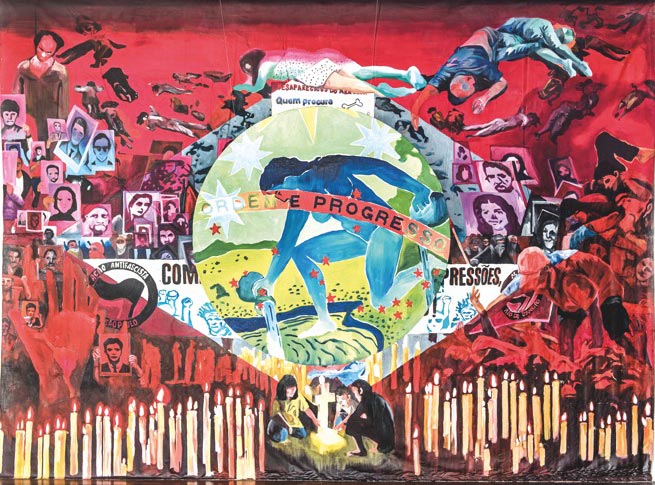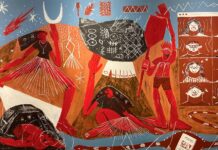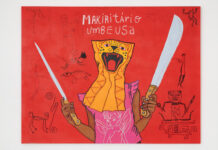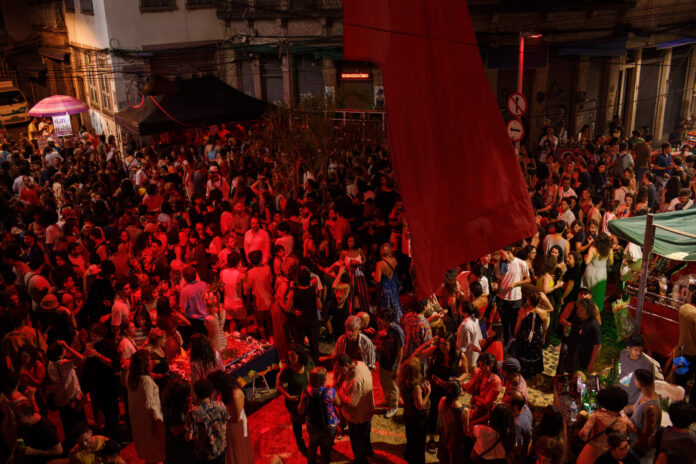*By Clarissa Diniz
Nthe exhibition center SUTUR|AR RELEASE|AR — solo show by Marcela Cantuária presented at Centro Municipal de Arte Hélio Oiticica in July — was the Tarot mandala developed by Alejandro Jodorowsky with the intention of showing its simultaneous unity and plurality: “The Tarot has to be seen. (…) It is a language that speaks of the present”1, and not of the future.
Interpreting the Tarot is also therapeutic. According to Jodorowsky, when faced with his “images rich in symbols”, we must “reject [the meanings] that are the product of anguish and choose those that [bring us] closer to divine consciousness”2. It is, therefore, as a collective therapy that Marcela Cantuária has faced the images of traumas and colonial wounds, choosing, in her vast imagination, those to which she is dedicated to interpreting, attributing meanings to them.
His work produces a unique imagery by intentionally corrupting hegemonic history and the meanings it attributes to collective memories. Canterbury provokes glitches and renders the images left by the colonial world faulty, pulling up the necessary symbolic space through which his allegorical paintings sprout. Constituted from collages of different images, taken from different contexts and resignified under the singularity of the aesthetic-political regime of her paintings, the artist's allegories dispute the current historicity, occupying it with heroines, anonymous people and memories that have been hers programmatically. excluded.
***
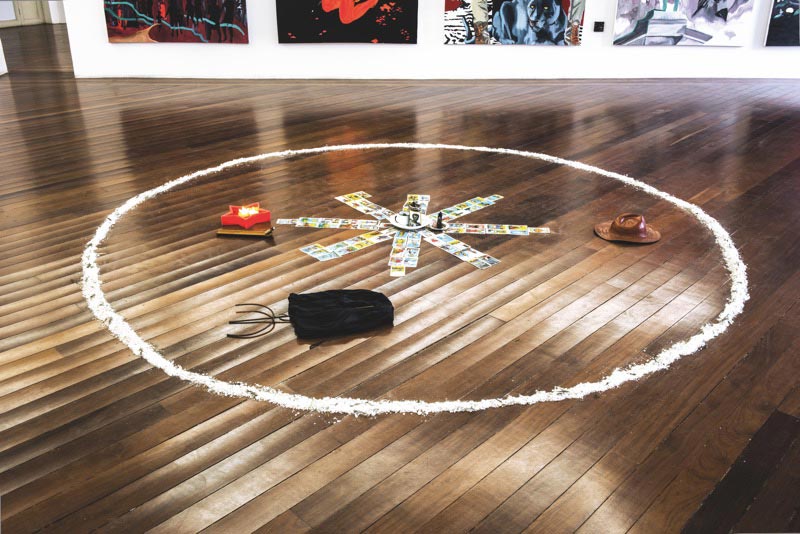
There were many allegories gathered in SUTUR|AR RELEASE|AR.
Around the mandala were the paintings from the series Queens (2018) – four women whose potencies are allegorized as updating and refounding the archetypes of the Tarot ladies. As allegories, they are based on the symbolic and social force of elements such as pigeons, scythes, bikinis or balaclavas, painted, in turn, as parts of a regime of intensity of color, matter and space that imply, at the same time, , our retina, our body, our memory and our imagination.
The female archetypal dimensions were, in turn, combined with allegories of warriors, activists, mothers, activists and other women whose lives were and are synonymous with the struggle for social justice and freedom. Among others, Jovita Feitosa, Juana Azurduy, Dolores Cacuango, Tránsito Amaguaña and Marielle Franco are part of the series Free Mother (2018/19), in which they are allegorized through the symbols of the struggles they fought. The paintings establish images in which these women are not an index of a lost battle, but icons of a liberated and matriarchal territoriality: historicity based on a future already inhabited by them insofar as it was their stories that constituted it and that allowed it to reach here in the form of a struggling future.
No wonder, I will come back and I will be millions – a phrase by indigenous revolutionary Tupac Katari – becomes the title of the painting that Cantuária dedicates to Marielle Franco, who, seated in a chair-throne of a mother of saint who became an icon of the Black Panthers (symbolized, in turn, by a panther at the feet of the central character), holds Governor Wilson Witzel's head on a spear while, on his chest, he holds the image of Favela da Maré.
Of the vast set of allegories proposed by Marcela, two stand out that deal directly with symbols of power, colonization and the nation: the Christian cross (Never a star on the northern flag, 2019) and the Brazilian flag (ghosts of hope, 2018). Fragmented by the artist's allegorization, while the cross appears in parts and upside down, the flag has its central circle detached from the painting's plane, acquiring a verse and only fitting back together when our body, in the center of that spatiality, makes it coincide. the installation's leakage lines. To these decomposed structures, Cantuária superimposes adverse images of Brazil's formation and present day, contradicting its interpretations and official meanings.
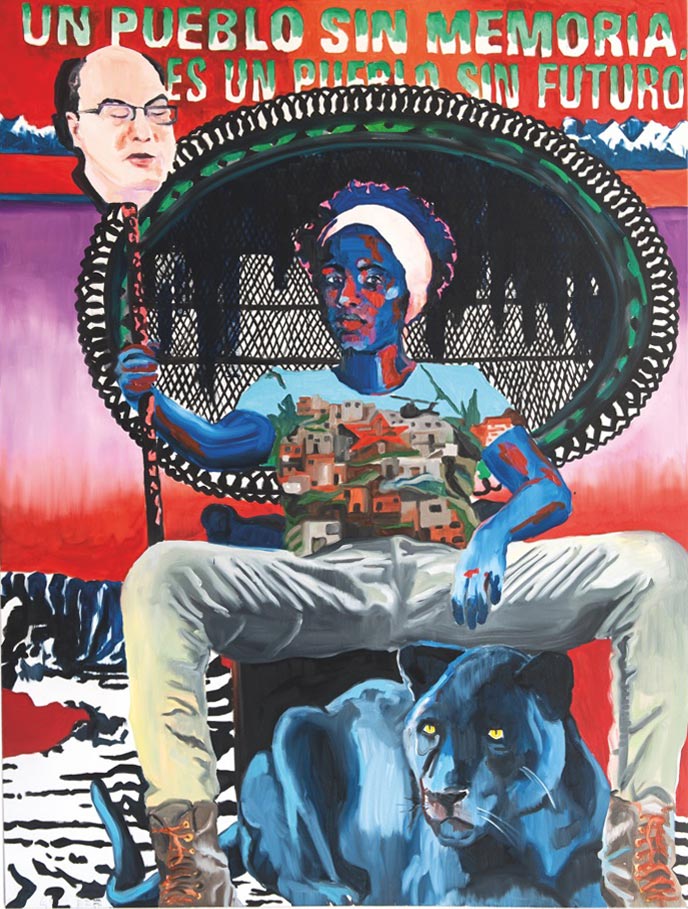
As also happens in the series of paintings dedicated to dictatorships in Latin America, wars or industrial work and their exploratory relationship, Marcela Cantuária's iconographic research finds symbols and images that, when related, assemble the allegories that warn us of the cohabitation of other stories. in the interstices of official history. From the memory of past struggles and the evocation of the forces of the future, she elaborates an imaginary whose historicity is not limited chronologically, but politically. As an allegorist, she does not “portray” characters or “represent” historical moments: the materials of Canterbury's works are less the images than the imaginaries – ambitiously and insurgently – performed in her allegories.
Because they are made within the scope of the social senses, these paintings are offered to our “interpretation” like a Tarot deck, willingly inviting us to read them so that they can, in turn, be realized. Its political – and socially magical – force is that of being an instituting imaginary that, by enabling it to recognize itself as the collectivity interested and capable of interpreting them, institutes a kind of semantic community whose social, political and aesthetic ties are experienced through of Marcela Cantuária's allegories. Our symbolic universes are populated by the imaginaries that the paintings perform and the corps magnetized by them: in front of so many people and so many voices, we feel less alone.
While establishing a community with which different subjects can be identified (including those who occupy contradictory social positions), Marcela Cantuária – who has militated with the Popular Brigades for years – seeks to pave singular political-economic trajectories for her work, aiming to rub the complicity of art with a benevolent and cannibalistic patrimonialism that consumes everything because it buys everything. Therefore, at the end of SUTUR|AR RELEASE|AR, do not sell I will come back and I will be millions for one of the many collectors who disputed it and, alternatively, donating it to the Maré Museum, is a political gesture that expresses a committed position with pain and its therapy beyond an extractive allegorization.
This is what the artist claims when, after the donation, it focuses on our responsibilities regarding the social address of the art we produce: «donate to those who hurt».
¹Alejandro Jodorowsky on the Tarot de Marseille. Excerpt from the movie extras the holy mountain.
²Alejandro Jodorowsky and Marianne Costa. The way of Tarot: the spiritual teacher in the cards (2004). Author's translation.

